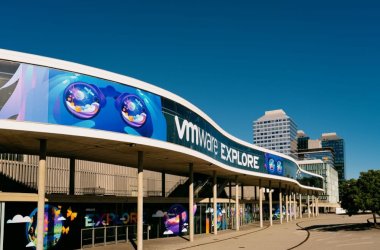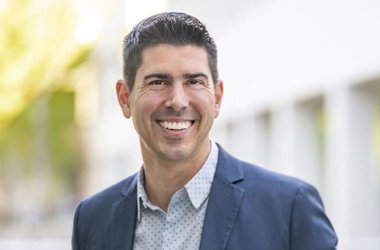
In the second part of the interview, Paul Maritz, CEO of VMWare explains the path ahead for the company across the entirety of any organisation.
Q: Is there a direct relationship between the community ecosystem & external services provider and Vblock?
A: No. A lot of those guys are, but not exclusively, using Vblock. Vblock is really a lower-level construct. Vblock is just an efficient way of providing the hardware basically.
Q: You’re saying then that they’ll be using all five elements of your stack, of your infrastructure, so they could appear as a transparent extension to my enterprise infrastructure.
A: That’s exactly what we’re trying to do. Right now it’s “your mileage may vary,” but that set of six that I mentioned are committed to have 22 data centres started up by the end of this year around the world – a
substantial investment.
Q: So, Paul, once you go beyond the enterprise infrastructure play into areas like platform as a service and beyond, how do those elements play out?
A: I’ll talk about that. Those five elements I talked about make up one layer. We think of it as three layers.
Layer 1 is essentially our take on infrastructure transformation, which is very firmly in the context of this hybrid cloud – that most businesses are going to have both internal and external infrastructure. Both need to become more efficient in a fundamental way, and that infrastructure has to handle existing applications above all else.
Customers can’t afford to rewrite or abandon their apps, so that infrastructure has to be good at handling existing applications. That’s why virtualisation is so important, because the real profound thing about virtualisation is it really encapsulates an existing app. When you virtualise, you’re taking an application and the operating system and the middleware, you’re putting it in a black box, cutting the tentacles of
complexity that tie it to the details of the underlying infrastructure – which allows you to kind of jack the black box up, slide the new functionality in, and slide the black box around.
Q: All at the infrastructure level?
A: Virtualisation is kind of the on-ramp for existing apps on that journey. Now, the challenge is it’s not the only thing that’ll happen going forward. Customers are now very focused on a infrastructure transformation journey; they’ve invested in this over the last two years, they’ve by and large seen good returns.
They know they have more to do, but they now are starting to say the fundamental issue that we face is really our applications. Because if we’re stuck on 20- and 30-yearold application code that was written for
an era of paper bills, we’re going to have a problem servicing the Facebook generation.
People are going to want to see and consume and manipulate information in a far more flexible and fluid way than they’ve done in the past.
We believe that over the next five to ten years, as big as infrastructure transformation is, that there’s going to be fundamental application transformation that needs to happen. Given our theme of trying to look for the important tides of history, we see that developers over the last few years have kind of revolted against complexity and have taken matters into their own hands.
You see coming out of the development space all of these new modern programming frameworks, whether it be Ruby on Rails, Spring, or Django, none of which came from the established vendors.
There’s this developers’ old saying: A pox on your complexity, we’re going to do this in a simpler way. That’s certainly where the new lines of code are being written, so that’s one fundamental change. The other is that developers increasingly want to consume things at a high level. They don’t want to have
to worry about cobbling together middleware and mapping into virtual machines, etc. They want all that just handled for them.
Q: That is certainly an ongoing trend.
A: And thirdly, the new data fabrics, because coming out of the consumer space, they’ve already had to confront huge amounts of data which can’t be handled through a traditional relational database model. You’ve seen the Hadoops and Cassandras and Reax, and they’re all coming out of the consumer, Internet side of things.
We think that new programming frameworks wanting to consume things at a higher level and new data fabrics are really a disruptive change in that industry – and they will be the foundation of application
renewal. We’ve started to invest in that space in the context of originally acquiring the Spring programming framework, which was technically, arguably the best of breed in this area. In trying to identify the next-generation middleware, we’ve acquired the GemFire distributed data fabric.
But in addition, it was our belief starting about two years ago that it would be an unnatural situation if the world ended up with a couple of highly proprietary über clouds. That would be going back to the mainframe era of the ‘60s and ‘70s, you know, where you basically could write an app for IBM’s world or Digital’s world or whatever. Moving between them was very, very difficult.
Then Unix came along as a way of kind of bridging that, and it got morphed into Linux and strengthened as it became an open source movement. It is our belief that the developers and the open source world in particular would not eventually tolerate a world of highly proprietary clouds, that eventually out of the open source world they would find a way to basically come up with a new cloaking layer that isolated applications to a greater or lesser degree from the details underneath.
The very loose analogy that you have to be careful about is, if virtualised infrastructure is becoming the new hardware, what’s going to be the new operating system? What will play the role of Linux in terms of isolating you from any details down there?
So a couple years ago we hired two senior developers out of Google who had worked on Google’s internal infrastructure, and one had a Microsoft background. We said, If you were to do this again, how would you do it? And in particular how would you construct a layer that filled that vacuum? That’s what became Cloud Foundry. And we said if we’re going to come up to that layer and if it’s to fill that vacuum, we can’t
keep it proprietary, we have to make it open source. That’s why we not only released it under an Apache 2 license, so it truly is an open layer in that sense.
Q: Do you see it as competing with OpenStack?
A: It really sits on top of OpenStack, at least as OpenStack is currently conceived. And we see Cloud Foundry, where we had to say you either play here or you don’t play, and if you play you’ve got to be willing to see this layer go everywhere. And we’re expecting it to go everywhere. Including on OpenStack,
and Amazon. People are already taking it and doing that.
Q: What about comparing it to Azure. Are they apples and oranges?
A: Basically, yes. Azure is a complete proprietary stack. I mean, in some senses, you can say they are both platform as a service, but we actually think there’s a whole bunch of features that Azure doesn’t have. It’s conceptualised in a fundamentally different way. We have Cloud Foundry as an open source project, and we’ve started up cloudfoundry.com, which is where a developer can go and start kicking the tires
and actually write an app in this environment and see how it works.
But there is this dual element to it. One is that it’s actually Linux with a cloud, which is what we’re trying to do. And then we’ve said, OK, let’s stand up an instance, of which we think there will be many instances, where people can go and familiarise themselves with it. We’ve been actually kind of blown away by the response. We had over 25,000 developers signed up in the first month.
Q: It’s a virtual circle in the sense that all the work done in the open source part comes back in and benefits…
A: Well, it’s actually an interesting layer, because it has three interfaces. On the top it has a set of formalised interfaces that you plug these modern programming frameworks into. So we announced with the plug-in for Spring, the Ruby family, Rails, Sinatra, etc., and now .JS. People have already started to extend that, so we now have Erlang plugged into it and we’re expecting others to get plugged into it as well. It has a set of interfaces on the side, kind of figuratively speaking, where you plug in services. That’s where you can plug in different databases, queues, etc. We came with the usual suspects, MySQL, Mongo, etc.
But we expect people to plug other stuff in on that side. Then it has a binding layer on the bottom that binds it to the particular infrastructure that it’s sitting on top of. Those are formalised, well-defined interfaces.
Q: How do you monetise it?
A: We think over time we can do hardened versions of this for the private cloud world, that will be a classic open source-like model where you’re basically selling service and support. We think that we can plug services into the side, so we do have some very valuable services there.
If you look at GemFire, which is a very interesting kind of sleeper in the world of middleware, it’s one of the most strategic apps in the world – the app that the US Department of the Defence uses to track its
assets, real-time assets, is built on GemFire. So all of their vehicles that have telemetry on them are reporting their status into GemFire.
In theory, you can put up a map of the world and drill down into an aircraft somewhere and find out in real time how much fuel it has onboard as it’s flying. That thing gets 60,000 position updates a second, which you can’t do on a relational database. It just cannot be done. Those kinds of things we can plug into
Cloud Foundry and monetise it that way – very important.
Q: Platform as a service has been the slowest to take off of all the cloud categories. What makes you think that Cloud Foundry is going to take off where others so far have not?
A: As I said, we’re deliberately shooting ahead, and we think there are two tales. There’s a tale around existing apps, which explains why the IaaS layer took off first, because it allows you to address existing
apps. But we think over time, people are going to want to move expenditure from infrastructure towards apps.
Q: Would you say that the level of desktop virtualisation adoption has been a little disappointing?
A: Well, it all depends on the sort of bar you began with. I think it’s fair to say that in the Gartner hype cycle we’ve come down a bit from the inevitable hype. But we actually think there is something profound playing out, which is that in the immediate term, businesses are confronted by the fact that more and more of their users don’t want to have a PC in their hands. They want to have a tablet or a smartphone and businesses can’t stop that.
The days when IT could say, “We specify that everybody in this company will have a black Dell laptop with this build of Windows on it,” are rapidly passing and they’re never coming back. The challenge is that the Windows desktop plays two roles inside IT. On the one hand, it was the interface to a particular OS – Windows. On the other hand, it was the conduit through which IT provisioned capability to a user. That’s where they installed apps, dropped files, turned menus on and off, etc. In a post-PC world where Windows isn’t the only player in the enterprise, that second aspect of the desktop can’t belong to any particular device. And there’s a vacuum. IT doesn’t know how to address that today, so there’s going to have to be change.
Secondly, and this is more speculative, the thing that’s profound about the post-PC era is not just a form-factor change, it’s actually a change in the way people work. The GUI stuff started with work done
across the road here at Xerox PARC and then through Microsoft Windows and Mac. It was all about how do we automate a desk circa 1975?
You can see the terminology – the desktop, files, folders, drawers – it was an automated typewriter, which is the word processor, you know. And it was a very document-centric world. Earlier white collar workers were seen as spending time creating documents. Today it’s not that they don’t create documents, it’s just not the centre of their universe anymore.
The centre of their universe now is consuming streams of information that are coming to you in much smaller chunks, and filtering, combining, commenting on, recomposing, and streaming that back out again. It’s in that sense that I think we’re moving into this post-PC world, a movement into a post-document-centric world. I think it’s the big change that’s going to play out here. It’s not desktop virtualisation, it’s really how does IT adapt to a post-PC era in terms of much greater device heterogeneity and a different way that people want to work in the context of those devices?
That’s a big set of wheels that we’re going to grind, and we’re trying to think about how to adapt ourselves to that world. We made our first baby step when we announced the Horizon App Manager Service, which is, if you sort of squint at it in the right light and you’re willing to make a few heroic leaps of faith, the beginning of the emergence of that device-independent desktop or workspace emerging.
Q: Why do you think VMware is well positioned to serve that function for these new devices, new types of applications.
A: Well, we see it as two reasons. One is we have a form of an entry in that space through our desktop virtualisation today, and that technology will be useful in this world, because it allows us to project into … all of these areas [as] an evolutionary transition. In our view, technology can inform part of the evolutionary bridge into that world, so we are selling into that world today. We have our foot there.
Beyond that, it’s white space. There’s no one who is … overwhelmingly the natural possessor of that space. For a company like us, as I said, we have to go where others haven’t. We like to see white space and say, How do we go there?
Q: Today, people say: VMware, the virtualisation company. What do you want them to say in five years from now?
A: I’d like them to say: VMware, the cloud IT company.
Q: What about apps?
A: By and large we’re going to stay away from the app space. Although we have some capabilities to consider apps, we intend to become part of the foundation. So basic email transport capability will become part of the foundation. That’s why we acquired Zimbra, it gives us that capability. But in general,
we will stay away from apps – we want to be an enabler for apps. We would rather be working with and cultivating the app community going forward.
Q: What are the key things you want CIOs and IT managers to know about VMware?
A: The most important thing that we want them to know about VMware is that we are constructing an infrastructure transformation journey that is very real and very actionable. It’s not something where they have to believe they have to invest now to get a return five years from now on that infrastructure. But it will actually lead them to where they need to be so that down the road they can free up the funds to go after application transformation and end user transformation.





